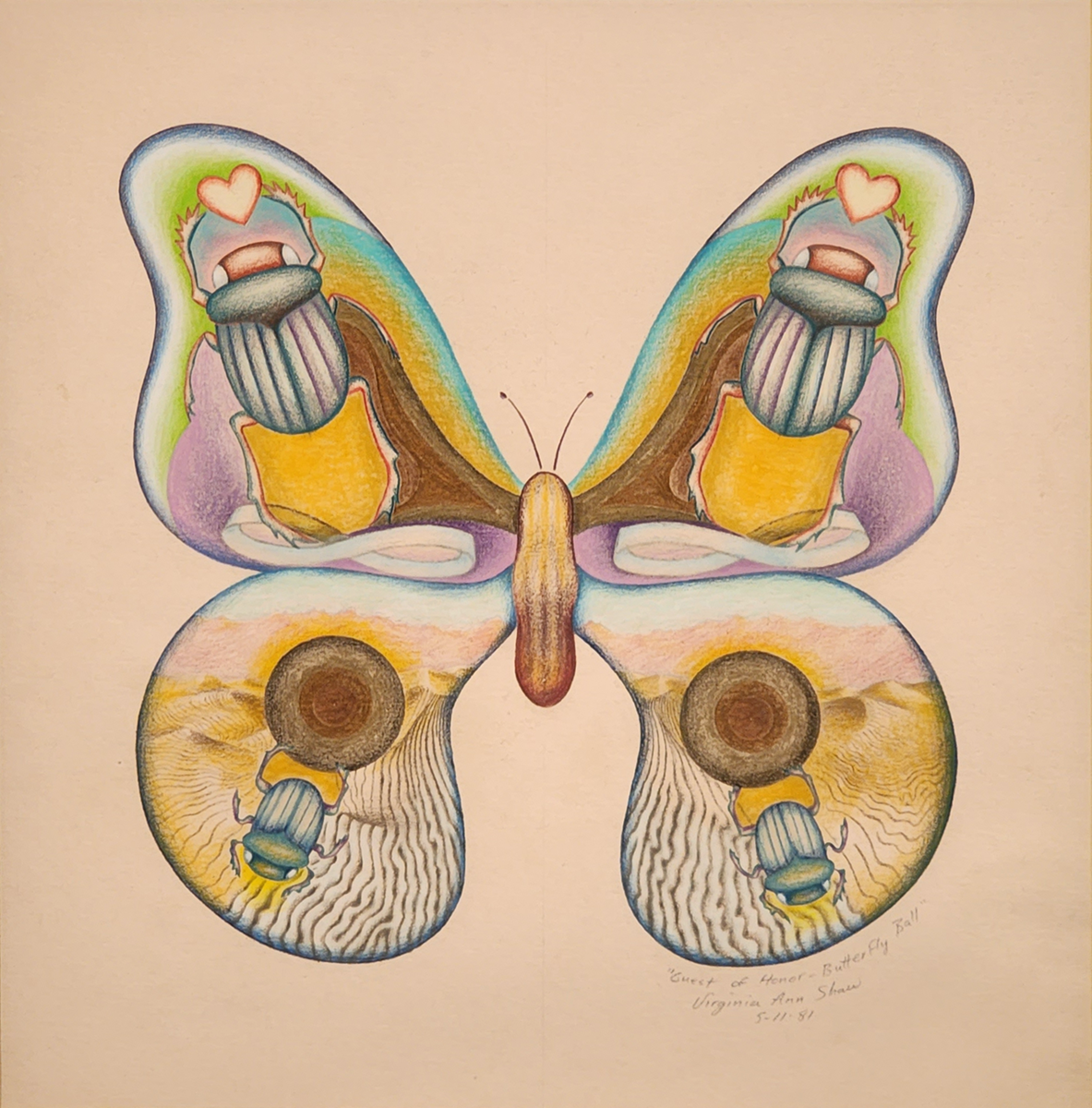Director's Notes Issue No.4
Leading With Drawing
Margaret Davidson, Button Rain, 2005, colored pencil on rag paper, 24” x 30”, collection of Ann Randlette
Visitors to the Museum of Northwest Art will be delighted to be taken on a journey as they walk into the upstairs galleries. Here, Margaret Davidson: Leading with Drawing offers a double take on drawing by featuring a selection of the artist's works in conversation with drawings from the Museum's permanent collection, specially hand-picked by Davidson herself. Many of these pieces have never been shown before. The results are absolutely delightful: Davidson delved enthusiastically into the collection of drawings and selected more than 40 pieces. She also shared with the audience what attracted her, captured her, and kept her engaged with each piece she chose, taking us by hand on a journey down graphite lane while sharing her wonderment, puzzlement, joy, and reverence for these artists and their drawings.
Margaret Davidson: Leading with Drawing addresses the unparalleled surge that drawing as an art form has been experiencing in the art world. Today, drawing is an intense, sensitive, compelling, personal, and utterly direct art form, no longer governed by the need to be a preparatory stage for painting or sculpture.
Over the past three decades, artist Margaret Davidson has focused her drawing practice on the intriguing relationship between reality and illusion: the tangibility of the pencil marks and surface of choice—paper, but also natural things such as sticks and dried leaves—and the illusion of three-dimensionality she masterfully achieves. Her uncanny drawings of buttons are convincing illusions of buttons. The artist likes to contrast this illusion with the texture of the surface they are drawn on, or the actual graphite or ink marks they are drawn with, in a search for that revelatory moment when both illusion and reality are disclosed to the eye and a revelatory oooooooohhh fills up the silence of the gallery.
DETAIL — Margaret Davidson, Button Rain, 2005, colored pencil on rag paper, 24” x 30”, collection of Ann Randlette
Always meticulously ambitious in scope and astonishing in execution, whether buttons, pebbles, grains of sand, skeins of wool, or newspapers arranged in spiraling forms, Davidson's drawings reflect the artist's fascination for an ancient design symbol known as the 'circle-dot.' As in a mantra—that is, a sound repeated over and over to aid concentration in meditation—Davidson often covers the surface by repeating the same form. As in meditation practice, she believes this creates a pathway into deeper and deeper awareness, allowing the mind to soar to universal heights.
With more than 40 drawings selected from the Museum's permanent collection and, alas, with limited space on this blog, I am sharing a small but enlightening and entertaining selection of pieces accompanied by the artist's unique commentary. Enjoy!
There’s more than one drawing here.
I feel as though I am looking at at least three drawings superimposed, starting with a squarish one like rock art and ending with a sort of scientific skeletal line drawing.
I’m not sure. But the mystery of this image, which is just ink on paper, has caused me to travel mentally over centuries of time.
Sherill Van Cott, Horse, no date, ink on craft paper, 12.25” x 14.75”, MoNA Permanent Collection, gift of Marshall and Helen Hatch
I know I am looking at a piece of paper with ink on it and that it has a precise thickness and edges and everything. Still, when I look at this drawing, I see depth: deep, deep black that you can sink into and maybe never touch the bottom. There are many, many, black inks in the world, and some of us grind our own, all in search of what Okada has here: this perfect, deep, timeless, blackness.
Frank Okada, Untitled, 1965, sumi ink on paper, 13” x 15.25”, MoNA Permanent Collection, gift of the Blair and Lucille Kirk Collection
The eggs are clustered close together and are in the shadowy interior of the nest. After that, every line of this drawing is put in to shelter and protect the eggs. Gilkey’s lines move in a caressing, protective way, and they actively communicate with us about the warmth of home and how it’s colder further out from the heart.
Richard Gilkey, Bird Nest, 1969, charcoal on paper, 24” x 36”, MoNA Permanent Collection, gift of Jan and Ken Wherry
I picked this image because it is one of the few drawings we have by Helmi (most of her works are linoleum block prints). This looks like it might be graphite, or maybe colored pencil, or Conté crayon.
A sisiutl is a three-headed monster know to the Kwakwaka’wakw people (formerly the Kwakiutl).
It is a frightening being, and Helmi has captured that scariness by being measured and direct.
Her monster looks straight at us.
Helmin Juvonen, Sisiutl, no date, colored pencil on paper, 17.25” x 25.5”, MoNA Permanent Collection, gift of Simon and Carol Ottenberg
This seems so simple but is, in fact, deeply complex.
A bird emerging from the egg . . . With a mere seven ink lines - and all the powerful space pulsing around those lines - we are given a picture of Life itself.
Georgia Munger, Emerging Face, 1976, ink on paper, 19.25” x 22.25” (framed), MoNA Permanent Collection, gift of the Verne Mittlestadt Collection
This is the kind of drawing that changes while I look at it. Branches turn into the sides of slopes, grasses turn into pathways—Goldberg draws with both the charcoal and the paper. The light areas are marks also, not just passive spaces. The joy of this work is that you could look at it every day for ten years and then suddenly see something completely new in it.
Joseph Goldberg, Untitled (West Wall of Grand Coulee, North of Soap Lake), 1986, homemade charcoal and wax on paper, 20” x 23.25”, MoNA Permanent Collection, gift of John and Diahann Braseth
When a drawing is tiny, you have two ways of seeing it: one, you can take the whole thing in at a quick glance, noticing the subtle, slightly off-center figure drawing with lots of detail, and two, you can lean in to look closely and become immediately pulled into an intimate, private mental conversation with the artist. Wehr always did tiny drawings and tiny paintings.
This one is worth looking at both ways.
Wes Mehr, Flower Shaman, 1977, ink on paper, 4.75” x 4.5”, MoNA Permanent Collection, gift of L. De Wayne Young
Color and joy along with exact balance—Aurora Jellybean did her own thing, even while spending time with the local Fishtown lads who had different ideas about art back in the 1970s and 1980s. Such color when everyone else was using black and white, such balance when everyone else was being asymmetrical.
It is worth it to us to look closely and enjoy her perfect uniqueness.
Aurora Jellybean (Virginia Shaw), Guest of Honor, 1981, colored pencil on paper, 20” x 19”, MoNA Permanent Collection, gift of Donald and Gloria Wampler
I chose this drawing because it has at least three dichotomies:
It is simple but also complicated
It is quiet but is a picture of sound
There is no ground line anywhere, but we can tell the three birds occupy three areas relative to each other.
With just a few strokes Graves has me thinking about birds, and believing in birds. That is powerful drawing.
Morris Graves, Untitled (Three Birds Singing), no date, crayon on paper, 16.75” x 22.75” (framed), MoNA Permanent Collection, gift of Paul I. Gingrich, Jr. Collection
Upcoming
Learn more about the exhibition and be inspired!
Drawings are for all of us one at a time: Lecture by Margaret Davidson
Saturday, September 23, 2023
2 - 3:30 pm
Join curator and artist Margaret Davidson for a lecture inspired by her exhibition Leading with Drawing.
Margaret Davidson Workshop: Drawing Exploratory Class
Saturday, September 30, 2023
11 am - 5 pm
In this one-day workshop, we will throw ourselves into the fun - and sometimes the surprises - of discovering the relationships between the drawing mark and the drawing surface.
Margaret Davidson has a BFA from the University of Michigan and an MFA from the University of Washington. She is both an artist and illustrator and, until retirement in 2014, taught courses in Beginning Drawing, Sources of Modernism in Drawing, Aesthetics of Drawing, and various drawing technique classes at Gage Academy of Art in Seattle, Washington. Davidson is the author of Contemporary Drawing: Key Concepts and Techniques, published in 2011 by Watson-Guptill, a division of Random House, New York.














